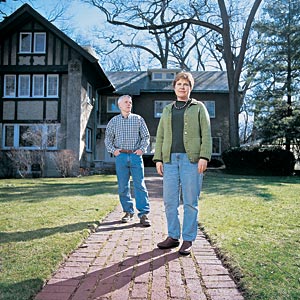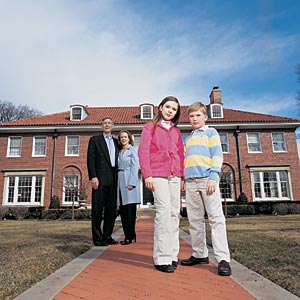|
Photography: Katrina Wittkamp
 |
|
The Currans
John E., 52; Susan, 50 (John M., 19, and Robin, 14) John is a stained-glass artisan and Susan is a freelance editor. |
The house: The C. S. Pellet house (1915), built in the Spencerian style with a decorative motif and steep gables; four bedrooms
Years living there: Nine
Wright connection: Architect Robert Spencer (of Spencer and Powers) befriended Wright in the early 1900s, and together they created the Prairie school of architecture.
Original owner: Clarence S. Pellet, an insurance executive who was active in professional and civic organizations in both Oak Park and Chicago
Favorite room: The living room on the first floor. “The fireplace is in the living room, and there’s also a radiator,” John says. “Ever since I was a kid I liked sitting by the window on a warm radiator. It’s something that has stayed with me.”
Creepy coincidence: “The previous owner died in a scuba diving accident. Shortly after, the plumbing froze and the whole house flooded.” The Currans bought and pledged to restore it anyway.
Most expensive renovation: Repairing the flood damage. “Parts of the ceiling were falling down; flooring and cabinets were destroyed. It cost us about $150,000.”
Landscaping: A pond with about 25 goldfish; more than 20 mature oak trees. “We have someone come out each year to maintain the trees. An oak tree takes 150 to 200 years to grow. You’d be a fool not to invest in caring for them.”
Prized possession: The architect’s original blueprints and spec book
Unusual detail: A tulip motif carries throughout the house, featured on the light fixtures, living room mantel, and more than 100 original stained-glass windows. “The original owner was a big fan of gardening,” says John. “If I built the house, would I pick a tulip? Probably not.”
 |
|
The Rosseaus
Rick, 52; Gail, 49; Natalie, 11; and Brendan, 9 (Laetitia Battisti, the au pair, 20) Gail is a neurosurgeon and Rick is an orthopedic surgeon. |
The house: The William Sloan house (1926), a Georgian Revival mansion with English architectural influences; six bedrooms in the main house and two in the coach house
Years living there: Six
Wright connection: The architect, Charles E. White (of White and Weber), was a student of Wright’s in the early 1900s.
Original owner: The house was built for William Sloan, the inventor of the Flushometer, the valve for the modern tankless toilet. The house includes 12 bathrooms in all. “Two weeks after we moved in, I opened the door of what we thought was a closet and stumbled upon yet another bathroom,” Gail says.
Selling point: A 45-foot underground tunnel connecting the main house to the coach house. “You open this big, creaky door and we’ve built a walk-in wine cellar down there that holds 1,000 bottles. That’s something you usually only see in Europe.”
Previous owner: Dorothy Comiskey, the granddaughter of White Sox owner Charles Comiskey. “When we moved in, we found drawers full of old press clippings from the 1940s about her husband [Sox pitcher] John Rigney and [broadcaster] Jack Brickhouse.”
Most expensive renovation: “We turned a spidery old laundry room into an eight-seat home theatre, complete with La-Z-Boys and soda holders. We have a lot of movie nights on the weekends.”
Unusual detail: The property includes a 10-by-14-foot two-story playhouse built three years ago for the Rosseau children. “It has a balcony, small furniture, tiny windows, and a little ladder. It’s even wired for the Internet.”


